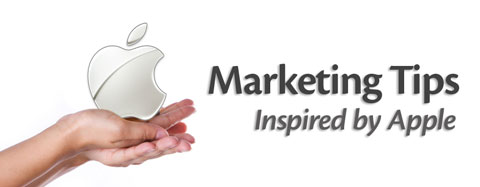
There are a lot of things small businesses can learn from Apple's success, and most of them easily translate from the corporate world to the small business world. The strategies that set Apple apart from its competitors are strategies that you can learn to use too. If you're lucky, you might just grow a fan club the size of Apple's. Read more to see what Apple can teach you about marketing your business.
It’s important to be pretty.

In all of Apple’s product lines and marketing materials, you won’t find a single thing that isn’t pretty. From their product design, to their product packaging, to even their television ads—Apple spends a considerable amount of time making their stuff look better than the competition. As a small business owner, you probably should too.
There are several opportunities for your small business to have great looking materials. Website design is one place to show off; brochure design is another. Perhaps the most useful would be to create really awesome business cards. Of course, if your company sells products you should probably make them look great too.
People like big photos.
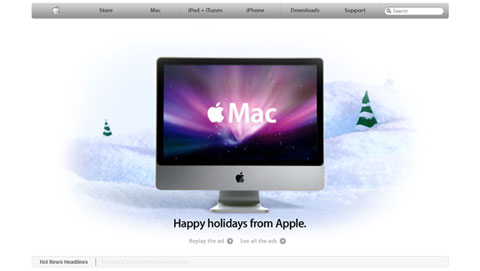
A quick look at their website, and you’ll see that Apple fully believes in the old adage “a picture is worth a thousand words”. With the amount of information and content floating around these days, I’d say I agree with them.
A good picture has more impact, it can be digested faster, and it can convey more feeling than a similar sized block of text. Images also just look prettier (see previous point).
Finding great images for your business to use can take time, but there are several resources available to help you. My favorite sources for images are Flickr (make sure to check licensing info) and iStockPhoto. With those two massive photo collections, and a little bit of time and effort, you should easily be able to come up with some powerful imagery.
Keep your message simple.
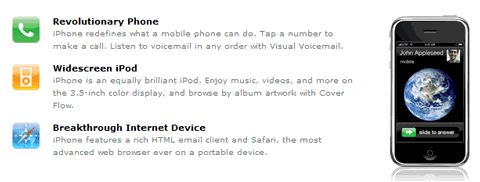
Apple’s been practicing what many authors and marketing gurus have been preaching: keep your marketing message simple. Simple messages are easier to understand, easier to remember, and easier to share.
Here’s an example, it’s Apple’s description of the iPhone: “Revolutionary Phone. Widescreen iPod. Breakthrough Internet Device.”
Stick to what’s important and keep your message free from extras. You’ll be following in Apple’s footsteps in no time (well, at least you’ll be better off).
Let your fans do the selling.
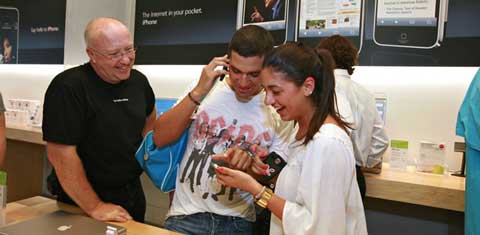
Look closely at any of Apple’s commercials, and you’ll notice something interesting. They all feature a customer or a user.
Apple’s strategy isn’t to tell you how cool their stuff is (since you probably wouldn’t believe them anyhow), their strategy is to show other people using and talking about their products. It’s just more personal, and more believable, when your fans promote for you.
One way to use this idea with your own business is to encourage your customers to rave about your product. The best way to do that usually involves exceeding their expectations and delivering a fantastic product.
Let the media do the talking.
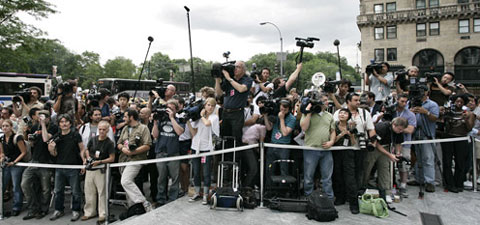
Instead of the traditional advertising blitz in the months and weeks leading up to a product launch, Apple takes a more subtle and viral approach. They like to slowly leak details about a new product, then give a presentation to ‘wow’ reporters and media people, and finally they put out a simple press release.
The end result of their careful lead up is that literally every mainstream news outlet (and thousands of smaller ones) starts talking about them. During this period, they don’t spend a dime on advertising for the new product.
The media can be a very powerful force, especially for small businesses—if you can only get them talking. By Apple’s example, you can do that by giving them something new and unique to talk about.
Create a unique customer experience.
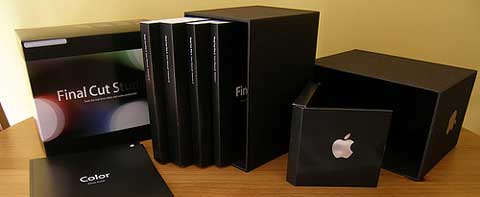
Every stage of customer interaction is carefully planned at Apple. The minute you visit their website it seems like you’ve entered a different web. If you visit one of their stores you feel like you’re at an exclusive party. When you finally buy their product, even the packaging makes you a part of Club Apple.
The consistency and uniqueness of Apple’s customer experience is one of the biggest achievements of their marketing department. Once you become a part of their fan club, it’s hard to turn back.
Creating your own unique experience is as simple (or as difficult) as deciding on what makes your company special and showing that consistently through all of your customer touch-points. As challenging as it may be, creating a consistent and unique customer experience is one of the most rewarding things you can do for your small business.
Get a charismatic CEO.
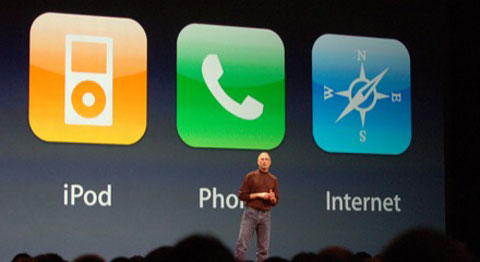
If a company’s head is in the right place, chances are its feet will be too. At least, that’s how a lot of customers see it—and Apple has taken the idea to heart. Having Steve Jobs present every new product Apple releases shows customers that upper-management cares. It also shows that the CEO is a smart, excited, and friendly person. Since he’s running the company, it’s only natural to think that the company will reflect his personality.
This is one of the lessons from Apple that is even more important in small business. Your customers will judge the quality and character of your business more by its upper-management than by its underlings, which means you have to get out there to show just how charismatic you and your business can be (since I’m assuming you are upper-management).
Always stay one step ahead.
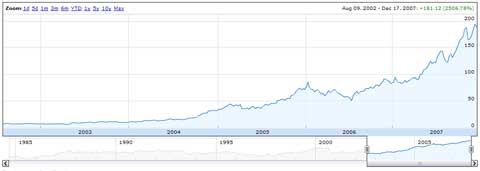
After Apple’s tremendous takeover in the mp3 player market (about 5 years ago), it would have been very easy for them to bask in their success and become complacent. But that isn’t what they did—they continued creating, releasing, and marketing new products. It’s a good thing too, because they’re competing with giants like SanDisk, Microsoft, Creative, Samsung, and many others.
One of the best things you can do for your marketing efforts is to keep your product one step ahead of the crowd, that way there is no choice but to stand out. Apple has proven this fact time and again, with the latest break-away release being the iPhone.
Did you know that LG, Samsung, HTC, and Nokia all have a big touchscreen phone, very similar to the iPhone? Most of them even have 3G, and most have more functionality than the iPhone too.
What makes the iPhone special is that it was released with a beautiful design, a simple-yet-powerful message, lots of pretty pictures, and an unequaled customer experience—all provided by Apple’s well-oiled marketing machine.
I don’t personally use many apple products (I’m a vista guy), but I wrote this article because Apple’s marketing machine really is superior to most other companies, and the things that make them great are all things that apply to small businesses too. Pay a little attention to what they do, and you might just get some great ideas for your own business.


